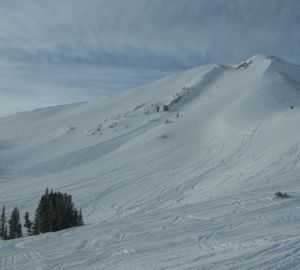The New Year’s avalanche fatalities
By Emily Stifler Explorebigsky.com Managing Editor
At 9 p.m. on New Year’s Eve, I was holed up with three friends in a dark corner of the Miner’s Saloon, in Cooke City. We were sipping whiskey and Bud Lights, and playing bad pool.
We’d rolled into town from Bozeman that evening, at the tail end of a storm that dumped three feet of heavy snow atop a weak base. That afternoon, as the storm lifted, the ridge top winds had blown more than 50 mph.
After a few rounds of pool, two guys from Great Falls put their quarters down on our table, challenging Pat and me to the next game.
One of the Great Falls boys broke, sinking two solids.
“Did you hear about the guy that died up on Henderson Mountain today?” one of them, Matt, asked, looking at us.
We shook our heads.
“Yeah, a guy from eastern Montana,” he said. “They dug him out in 12 minutes, but he died of trauma.” Matt described a massive slide on a wind-loaded slope in Fisher Creek, near Lulu Pass, a popular place above town for snowmobiling. We’d been planning to ski tour in that area the next day.
They finished us off quickly on the pool table, and I headed to the bar for another round. There, I overheard a conversation about a cross-country skier missing above town. Several members of the local search and rescue team were out looking for him.
We hung out for another hour, watching the Great Falls guys get quickly beat by a couple of sharks from North Dakota.
We sat talking about snow and avalanches, then just talking. By the time the karaoke started up, we’d lost steam. Before midnight, we piled into our room across the street at the Elkhorn Lodge and laid around watching Kenny Chesney on TV.
I was a long time falling asleep, thinking about the fatalities, and about the team of searchers still out that night.
—-
Similar tragic accidents occur almost every year in Cooke City and around the region.
Huddled in a deep, narrow mountain valley at 7,651 feet, Cooke is four miles from the northeastern corner of Yellowstone National Park. Originally built around gold mines, the town of about 100 is at the base of the Beartooth Highway and is a major tourist stop in summer. It has no cell service, and is at least an hour and a half from the nearest hospital.
In winter, when the Beartooth Highway isn’t plowed, Cooke is literally the end of the road. Since the ‘90s, it’s been a destination for off-trail snowmobilers from Montana, Wyoming, the Dakotas, Minnesota and Wisconsin. They outnumber backcountry skiers nearly 20-to-1, and the snowmobile club grooms trails to Lulu and Daisy passes, several miles out of town.
Ten- and 11,000-foot mountains rise directly above town, and the backcountry skiing and snowboarding opportunities are basically unlimited, says Jay Schifferdecker from the Silvertip Mountain Center in nearby Silvergate.
But this comes with inherent danger. The big, open terrain that characterizes the mountains around Cooke is serious avalanche country. Plus, the area attracts backcountry enthusiasts of all abilities.
“We get a lot of people here who haven’t been off the highway, or off a flat trail. Maybe they’ve been to a resort,” said Jeff Ohlinger, co-owner of the Elkhorn Lodge. “This ain’t a resort. It’s rugged here.”

By 8 a.m., snowmobiles were roaring around Main Street. I walked to the Bearclaw Bakery and ordered espresso and breakfast sandwiches on homemade biscuits to go.
In the Exxon, while Nick rented a snowmobile, I read the avalanche report and found out the missing skier, a Bozeman man, had also been buried in a slide and killed. Avalanche activity had been widespread across the region.
A handwritten note in red marker hung near the cash register, warning that the avalanche danger was high.
Susan Jack manages the Exxon and has been a Cooke resident for more than 20 years. Her partner Rick Sommers has been here his whole life; he owns the Exxon, which also rents snowmobile equipment. Rick and their son Lucas were part of the search and eventual body recovery the night before, which took place several miles up Hayden Creek, east of town.
“People have to use their judgment,” Susan said. “This is a wonderful place to snowmobile and ski… [But] when the avalanche danger is as high as it is now and was yesterday, you’ve really got to take a look at the big picture around you. That’s basic.”
She credits the Gallatin National Forest Avalanche Center with making avalanche information available to everyone, and says many businesses in Cooke are pitching in. Most post the advisory and talk to people every morning before they go out for the day.
Everyone in town is affected when something like this happens, said Lisa Ohlinger, co-owner of the Elkhorn Lodge. “Either you or your family are part of the search team, or the person who was killed was staying at your business.”
—-
At 10 a.m. we fired up the machines and headed out of town, Pat and I tandem on his snowmobile, and Nick and Carly on a Ski-Doo.
The first four miles up Fisher Creek toward Lulu Pass were on a flat trail nowhere near avalanche terrain. We stopped near a dilapidated mining cabin, just before the trail crossed under several slide paths.
The sky was gray, and a light wind blew snow across ridges 2,000 feet above us. An avalanche about 40 feet wide had ripped out in a north-facing gully above us, running 500 feet. In the next gully was a pair of ski tracks.
We skinned up a low-angle slope through trees, dug a pit, and stopped to practice with our beacons on a flat bench.
Nearby, we could see where a large avalanche had come down Henderson Mountain’s wind-hammered northeast face the day before. Even in the flat light, the debris pile was obvious. A five-foot crown line loomed 800 feet above, near the ridgeline.
Curious, we skinned up a treed rib between two of the avalanches and stopped in a safe spot overlooking the larger, easternmost one.
Six hundred feet above us, a shallow crown line contoured across the sub-alpine runnels for 500 feet. Another 400 feet above that was another, deeper crown. Two hundred feet below, a broken tree and a massive hole marked the spot where the snowmobiler was dug out.
We stood quietly, blown away by the destructive power.

After digging another pit and finding surprisingly stable conditions on lower elevation, less-steep slopes, we skied a few short laps in the trees. We snuck through tree alleys and mellow meadows, making turns in the kind of creamy powder that you want to spend the rest of your life skiing.
Having seen that avalanche, I couldn’t stop thinking about mortality, and about being in the mountains. It’s a place many of us go to seek personal satisfaction—in recreation, solitude or camaraderie.
The two victims were killed doing drastically different activities. One was high marking a wind loaded alpine slope with his snowmobile, something that puts massive force on a fragile snowpack. The other was ski touring up an easy trail in the mountains when he walked beneath an avalanche path and triggered it from below.
—-
If there’s a message in the aftermath of these tragedies, it shouldn’t be ‘Don’t go to Cooke.’ Instead, it’s about knowing when to be conservative:
“There are good days, and there are bad days,” said Doug Chabot, director of the Gallatin National Forest Avalanche Center. Last year, he noted, the snowpack there was exceptionally safe, overall. But over New Year’s weekend this year, the avalanche danger peaked more than it had in a long time.
“Right now and probably for a little bit longer, we’ve got higher avalanche danger. This year, because of the lack of snow in November, the snow structure is really bad. We’re going to pay the price on that for a while because it built all that loose sugary snow at the ground.”
But as we discovered, you can still travel safely in the backcountry, even during a high danger cycle.
“You just have to stick to slopes that are less than 30 degrees,” Chabot said. “You can have a blast, but you’ve got to be super diligent to pull that off.”
This also means accurately assessing if you’re on or underneath avalanche terrain; carrying an inclinometer and measuring every slope angle; and being aware of the consequences of even a small avalanche—all things our group did that day in Fisher Creek.
But all of this isn’t necessary just to stay alive in avalanche terrain. Instead, basic avalanche education is the number one thing people should get before they even get gear.
“It’s not about understanding the stability tests, or about the subtleties of reading terrain,” Chabot says. “The basics are what keep us alive a lot of the time—recognizing signs of instability like whumphing, shooting cracks, or seeing other avalanches. Education opens peoples’ eyes so they look at the mountains differently.”

Cooke City will host a hog roast to benefit the local volunteer SAR and EMS teams the weekend of March 9 and 10. The event will include live music, an auction and karaoke.
Upcoming avalanche courses
There are many avalanche courses available in Southwest Montana this winter. They range from one-hour awareness to in-depth courses for intermediate/expert backcountry users. The GNFAC courses are cheap and easy to take. The level one and two classes are more involved, and designed for people who are serious about spending time in avalanche terrain. For more details and a list of classes, visit mtavalanche.com/education.
For avalanche gear and rentals in Cooke City and Silvergate:
Bearclaw Bob’s, in Cooke next to the Super 8, sells and rents avalanche gear. (406) 838-2040
The Silvertip Mountain Center, in Silvergate, four miles from Cooke, sells and rents avalanche equipment. (800) 863-0807













